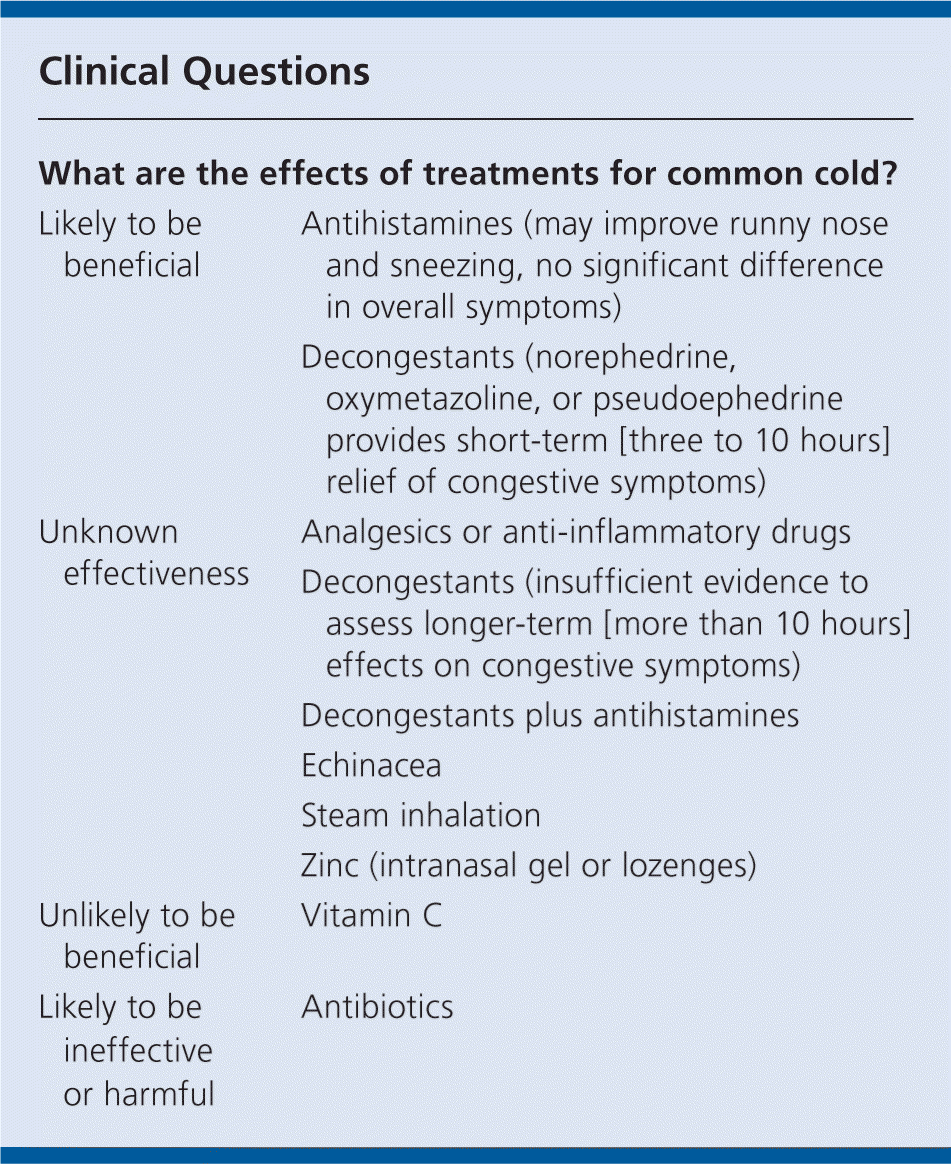
Am Fam Physician. 2011;84(12):1390-1391
Author disclosure: Dr. Arroll is on the advisory board for the Pharmac educational seminars, a government-funded pharmaceutical purchasing agency in New Zealand, and is on the primary care committee of the Future Forum, an educational foundation funded by AstraZeneca (United Kingdom). He is the lead author of two studies included in this review.
Transmission of common cold infections is mostly through hand-to-hand contact rather than droplet spread. Several types of viruses can cause cold symptoms.
Each year, children have up to five colds and adults have two to three colds, leading to time off from school or work and considerable discomfort. Most symptoms resolve within one week, but cough often persists.
Nasal and oral decongestants reduce nasal congestion over three to 10 hours, but we do not know how effective they are for longer-term relief (more than 10 hours).
Antibiotics do not reduce symptoms overall and can cause adverse effects and increase antibiotic resistance.
Antibiotics may improve symptoms after five days compared with placebo in persons with nasopharyngeal culture-positive Haemophilus influenzae, Moraxella catarrhalis, or Streptococcus pneumoniae, but it is difficult to identify which persons may have these infections.
Vitamin C seems unlikely to reduce the duration or severity of cold symptoms compared with placebo.
We do not know whether zinc gel or lozenges, echinacea, steam inhalation, analgesics, or anti-inflammatory drugs reduce the duration of symptoms of colds.
Antihistamines may slightly reduce runny nose and sneezing, but their overall effect seems small. Some antihistamines may cause sedation or arrhythmias.
We found insufficient evidence to assess whether decongestants plus antihistamines are effective in reducing cold symptoms.

| What are the effects of treatments for common cold? | |
| Likely to be beneficial | Antihistamines (may improve runny nose and sneezing, no significant difference in overall symptoms) |
| Decongestants (norephedrine, oxymetazoline, or pseudoephedrine provides short-term [three to 10 hours] relief of congestive symptoms) | |
| Unknown effectiveness | Analgesics or anti-inflammatory drugs |
| Decongestants (insufficient evidence to assess longer-term [more than 10 hours] effects on congestive symptoms) | |
| Decongestants plus antihistamines | |
| Echinacea | |
| Steam inhalation | |
| Zinc (intranasal gel or lozenges) | |
| Unlikely to be beneficial | Vitamin C |
| Likely to be ineffective or harmful | Antibiotics |
Definition
Common colds are defined as upper respiratory tract infections that affect the predominantly nasal part of the respiratory mucosa. Because upper respiratory tract infections can affect any part of the mucosa, it is often arbitrary whether an upper respiratory tract infection is called a cold or sore throat (pharyngitis or tonsillitis), sinusitis, acute otitis media, or bronchitis. Sometimes all areas of the mucosa, simultaneously or at different times, are affected during one illness. Symptoms include sneezing, rhinorrhea (runny nose), headache, and general malaise. In addition to nasal symptoms, one-half of patients experience sore throat, and 40 percent experience cough. This review does not include treatments for persons with acute sinusitis, acute bronchitis, or sore throat. One prospective study in the United States (1,246 children enrolled at birth) found that children who had frequent colds at two or three years of age were twice as likely to experience frequent colds at six years of age, compared with children who had infrequent colds at two or three years of age (relative risk = 2.8; 95% confidence interval, 2.1 to 3.9).
Incidence and Prevalence
Upper respiratory tract infections, nasal congestion, throat problems, and cough are responsible for 11 percent of general practice consultations in Australia. Each year, children have about five such infections and adults have two or three infections. One cross-sectional study of Norwegian children four to five years of age found that 48 percent experienced more than two common colds annually.
Etiology and Risk Factors
Transmission of common cold infections is mostly through hand-to-hand contact, with subsequent passage to the nostrils or eyes—rather than, as commonly perceived, through droplets in the air. Common cold infections are mainly caused by viruses (typically rhinovirus, but also coronavirus, respiratory syncytial virus, metapneumovirus, and others). Often, no infecting organism can be identified.
Prognosis
Common colds are usually short-lived, lasting a few days, with a few lingering symptoms lasting longer. Symptoms peak within one to three days and generally clear by one week, although cough often persists. Although they cause no mortality or serious morbidity, common colds are responsible for considerable discomfort, lost work, and medical costs.
